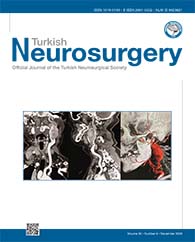2Tokat State Hospital, Department of Radiology, Tokat, Turkey DOI : 10.5137/1019-5149.JTN.24627-18.2 AIM: To present the radiological findings of fibrous dysplasia (FD) patients who had computed tomography (CT) and/or magnetic resonance imaging (MRI) scans.
MATERIAL and METHODS: This study included a total of 25 patients (17 female and 8 male) who were found to have FD based on CT examinations between March 2010 and July 2018. Involved bones, type of involvement (single or multiple) and CT appearance features (ground-glass, sclerotic, cystic or mixed type) were evaluated.
RESULTS: Age range of the patients with FD was 14-55 (mean: 29.92 ± 12.63) years. Sixteen patients had single bone and nine patients had multiple bones affected. Single bone most frequently involved maxillary bones. Multiple bone involvement affected up to four bones, sphenoid bone being the most frequent. Fifteen lesions were mixed type, eight were ground-glass and two were sclerotic on CT. Intense contrast-enhancement was observed in four patients on MRI.
CONCLUSION: Craniofacial FD is more frequent in young adults and women, and more commonly involves single bone, mostly maxillary and sphenoid bones. Craniofacial FDs could be of different types on radiological examinations depending upon their compositions.
Keywords : Computed tomography, Craniofacial bones, Fibrous dysplasia, Magnetic resonance imaging




